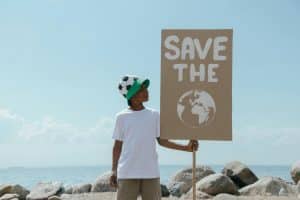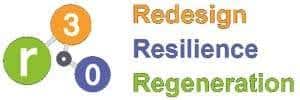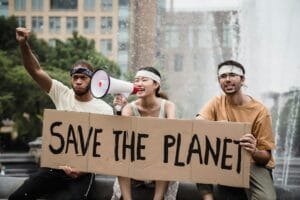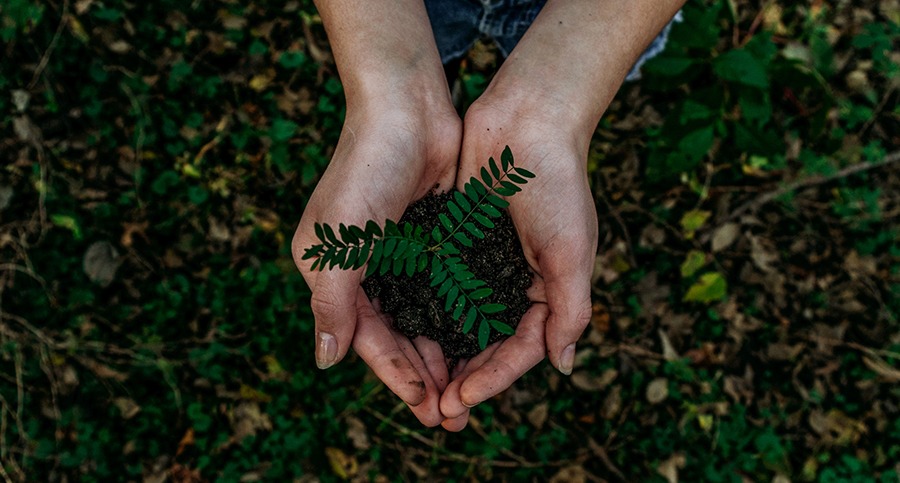The Dirty Secret of Urban Growth
Wealthy cities, typically within developed countries, generate enormous amounts of trash compared to their less affluent counterparts. In fact, a World Bank analysis found that waste correlates strongly with income and urbanisation. They report that developed countries (the Global North) produce 34% of solid waste, while developing countries (the Global South) account for only 5% of garbage (George, 2021). But how do these countries manage their waste?
Many wealthy cities “export” their waste to the Global South. This practice involves disposing of generated waste like electronics (E-waste), textiles, plastics, and radioactive trash (Liboiron, 2018). This results in massive piles of garbage from high-GDP, developed nations such as the US, the UK, or Japan filling up the landfills of Ghana, Morocco, or Indonesia (Greenpeace Middle East and North Africa, 2025). While it enables developed countries to exponentially grow their urban lifestyles, it comes with the cost of polluting the world’s most economically disadvantaged nations.
Wealthy nations exploit economic and environmental convenience by exporting their waste to the Global South, thereby passing on their burdens (Greenpeace Middle East and North Africa, 2025). Sangaralingam writes that “shipping the waste is much cheaper than managing or disposing of it in an environmentally sound manner in the regions where it is produced” (Sangaralingam, 2024). Rather than cutting consumption or improving local recycling, many wealthy cities opt to export their waste by offloading the burden onto less developed nations. This practice reflects what THRIVE defines as a Complex Wicked Problem under its Foundational Focus Factors (FFFs): deeply interconnected societal challenges that are hard to define and defy conventional solutions. The export of waste from developed to developing nations perpetuates a system defined by shifting responsibility, poor accountability, and environmental injustice.
What Is Waste Colonialism?
This exportation of waste from the Global North to the Global South is referred to as “waste colonialism”. It allows developed nations to exploit the lands of less developed countries as dumping grounds, reinforcing historic power imbalance and deepening global inequality under the guise of modern trade (Greenpeace Middle East and North Africa, 2025). While this not only raises major environmental and health concerns for the developing countries, waste colonialism is also a social issue.
Waste colonialism was first coined as “toxic colonialism” at the UN Environmental Programme’s Basel Convention in the late 1980s, when African nations protested against the dumping of hazardous waste by developed countries (Pratt, 2011). Yet parties to the Convention waited over 30 years before formally including plastic waste, a change that only took effect in 2021 (Salamat, 2024).
Waste colonialism operates through illegal or low-tech recycling operations that receive contaminated and unsorted waste, preventing proper recycling. As a result, operators often burn, landfill, or dump waste. Open burning releases toxic fumes, including dioxins and furans, which leads to air pollution. Rivers and groundwater become polluted with microplastics and hazardous leachate (Sangaralingam, 2024). Surveys conducted across Turkey have found that exported waste from the EU has led to excessive concentrations of substances such as chlorinated dioxins and heavy metals in their soil and water (Jedelhauser, 2023).
The Global South as the World’s Dumping Ground
For decades, wealthy cities have shipped their unwanted waste, including recyclables too contaminated or costly to process at home, to countries in the Global South. They often frame these exports as recycling partnerships or economic opportunities, but in reality, they tell a very different story.
High-Profile Incidents and Pushback
For example, in 2013, the Philippines received six dozen shipping containers labelled as “plastic recyclables” from Canada. When, in reality, these containers were full of rotten and contaminated garbage. It took six years of diplomatic dispute before Canada agreed to take the trash back (Forrest, 2022). As a result, some developing nations are taking a rigid stance to prevent illegal waste from being dumped on their grounds. For example, in 2019, Malaysia began sending back hundreds of tonnes of imported plastic waste to the UK, the US, and Australia. The Environmental Minister of Malaysia said that “we will not be a dumping ground to the world… we will fight back. Even though we are a small country, we can’t be bullied by developed countries” (ABC, 2019). These high-profile incidents reveal how Global South communities are used as the global garbage bin for wealthy nations.
The Economic and Social Inequities of Waste Processing in the Global South
One of the drivers of this problem is the economic lure of waste processing. In countries like Indonesia, Bangladesh, and Nigeria, informal economies around waste sorting and recycling provide livelihoods to thousands of people. But these jobs are often dangerous, low-paid, and unregulated. Workers, sometimes children, are exposed to hazardous substances daily without adequate protection (Ferronato & Torretta, 2019).
Waste also disproportionately burdens marginalised communities within the Global South. Research by the United Nations has shown that hazardous waste disproportionately ends up in less developed, often indigenous or rural communities, heightening existing social vulnerabilities (UN, 2021). This intersection of poverty, race, and environmental degradation creates a crisis of climate inequality.

Source: Al Jazeera, 2019
E-Waste, Plastic, and Toxic Trails
E-waste
Today, the Global South countries are primarily in Africa, Asia, and Latin America, which share a history of colonialism and face similar socio-economic challenges (Heine, 2023). In West Africa, Agbogbloshie, a sprawling dump in Ghana’s capital, Accra, ranks among the top 10 most polluted places in the world (Njoku et al., 2023). International observers recognise it as one of the largest toxic e-waste sites, posing serious health and safety risks (Grant et al., 2024). Wealthy nations, especially the EU, dump approximately 15,000 tons of discarded phones, computers, refrigerators, and other used electronics each year (Lambert, 2024). Agbogbloshie is home to an estimated 40,000 people, making a living by scavenging metals from e-waste. A study notes that in Ghana, the disposal of e-waste “fuels environmental health disparities” and constitutes an issue of environmental injustice (Njoku et al., 2023).

Source: Lambert, 2024
Similarly, in Lagos, Nigeria, an estimated 18,000 to 60,000 metric tons of old electronics arrive each year. These wastes are dense in lead, mercury, cadmium, and brominated flame retardants. Infants growing in these environments have shown higher rates of learning disabilities owing to lead exposure (Njoku et al., 2023).
Plastics
Europe, the US, Japan, and Australia are among the world’s largest waste exporters (EIA, 2021). For example, in 2022, the EU shipped 1.6 million tonnes of waste to Egypt and 1 million tonnes to Morocco alone. Every day, the EU ships over 3 million kilograms of plastic waste to the Global South, to countries such as Turkey, Malaysia, Indonesia, and Vietnam, where it is ultimately discarded (Jedelhauser, 2023).
Much of this waste is plastic packaging or consumer goods misclassified as “recyclables.” The reality is that many of these materials are either non-recyclable or mixed with contaminants. On top of that, many of these developing countries have weak waste laws, where open dumps are extremely common. Reports show that landfills in countries like Morocco and Vietnam have become hazardous, with overflowing garbage leaking toxic chemicals into the soil and water (Greenpeace Middle East and North Africa, 2025). As a result, nearby villagers suffer from rising rates of asthma and cancer as well as the spread of diseases like typhoid and cholera (Siddiqua et al., 2022).
textiles
It is not just plastic. Textile waste from fast fashion floods Global South markets. Tens of millions of cheap garments are sent as “donations,” but much of it is unsellable. In Ghana’s massive Kantamanto clothing market, up to 40% of imported bundles end up in large waste piles. This is causing a public health crisis, trapping retailers in debt and destroying the environment (stopwastecolonialism, n.d.). In effect, many in the Global South live the consequences of urban consumption in the developed world.

Source: James, 2022
Accountability Gaps in Global Urbanisation
Why has this global waste trade continued for so long? Largely, it is because accountability is diffuse. No single entity truly owns the problem once a container leaves a port. International waste shipments lack monitoring and accountability on the part of waste producers (Jedelhauser, 2023).
On the regulatory side, the Basel Convention and its recent amendments set rules. For example, the 2019 Ban Amendment prohibits hazardous waste exports from OECD to non-OECD countries (Break Free From Plastic, 2019). But enforcement is spotty. The developed world often redefines waste as “non-functional electronics” or “renewable fuel” to evade bans.
Wealthy cities also rarely feel pressure from their own citizens or governments to reduce this externalisation. Urban waste managers often focus only on domestic disposal targets. They pay little attention to where the recyclables actually end up (Break Free From Plastic, 2019). Without reforms from regulators and corporations, accountability will remain weak. These gaps push the consequences onto the Global South. THRIVE’s Systems Thinking FFF exposes how these accountability gaps are embedded within structural systems. The drivers of consumption and waste rarely bear the full cost. Without full lifecycle reporting, audits, or trade transparency, cities can appear to reduce domestic waste while simply exporting it abroad.
Toward Just and Responsible Urban Futures
The injustice of this situation has sparked proposals for reform at every level, from households to international agreements. This aligns with the principles of a Regenerative Economy, another of THRIVE’s FFFs. It pushes a shift from linear, export-led waste systems to circular, locally-managed models. This involves the reuse, remanufacture, and recycling of materials to retain their value and keep them in high-utility circulation. Some key examples include:
Sweden: Waste-to-energy
Sweden burns over 50% of its municipal waste in high-efficiency waste-to-energy (WtE) plants, reducing landfill use to less than 1% (Kim & Mauborgne, n.d.). It imports trash from neighbouring countries, converting waste into energy to heat homes via district heating systems. The country also promotes local textile recycling and repair workshops to make reuse easy and fun (Lassen, 2024). This demonstrates a closed-loop domestic solution and high national accountability.
France: Circular Policy Leadership
France introduced one of the world’s strictest extended producer responsibility (EPR) laws, mandating recyclability and repairability of electronics and appliances (UNEP, 2025). The country also leads in EV battery recycling and operates programmes for collecting and repurposing used frying oil into biofuel.
China: Zero waste cities & WTE expansion
China’s “Zero Waste City” pilot programme, launched in 2018 in cities like Shenzhen and Suzhou, aims to drastically reduce landfill dependency (Qi et al., 2024). Simultaneously, China has invested heavily in WtE plants, integrating digital waste tracking systems using AI and blockchain (Kurniawan et al., 2022).

Source: Dina’s Days, 2022
Conclusion and Call to Action (CTA)
The issue of wealthy cities exporting waste to the Global South underscores the darker side of urbanisation. It reveals how global systems of consumption and disposal continue to favour developed cities while sacrificing the health and dignity of less developed communities.
To create thrivable cities, policymakers must close international waste loopholes, invest in local reuse systems, and enforce product stewardship laws. Exporting waste is a systemic failure of design, not destiny. The THRIVE Framework provides tools for redesigning urban metabolism with justice, circularity, and solidarity at its core.
A thrivable framework
THRIVE Project (The Holistic Regenerative Innovative Values Entity) is a non-profit organisation that employs key principles from the THRIVE Framework to tackle global issues and complex challenges using key principles based on the 12 Foundational Focus Factors (FFFs).
The Sustainable Development Goals (SDGs), particularly SDG11: Sustainable Cities and Communities, SDG12: Responsible Consumption and Production, and SDG14: Life Below Water, provide a valuable foundation for addressing waste and resource challenges. However, they often fall short in practice. The goals outline what needs to change but not how to achieve it, leaving gaps in enforcement, monitoring, and accountability. As a result, issues like the global waste trade continue to shift environmental burdens onto vulnerable communities.
THRIVE goes beyond this conservation-focused lens by promoting thrivability, regenerating ecosystems and securing long-term benefits for future generations. For example, Systems Thinking adopts a holistic, long-term perspective on challenges, revealing how lifecycle responsibility is diffused. Regenerative Economy shifts away from the resource-intensive, linear model of waste management. It reframes waste as a design flaw rather than an unavoidable outcome. Values‑Based Innovation places ethical, social, and environmental values at the core of innovation efforts. It shifts the focus from short-term cost-saving to long-term responsibility and integrity. These lenses, when applied to successful urban examples, provide practical pathways towards thrivable waste governance. A push for Smart Communities is essential to uphold accountability, protect vulnerable communities, and foster equitable partnerships.
THRIVE Project aims to create a thriving planet by researching, educating, and advocating for equitable and effective solutions to global waste trade, ensuring environmental justice, responsible resource management, and long-term planetary health. To learn more about thrivability, check out the THRIVE website, which contains published articles and whitepapers on a wide range of thrivable topics. You can also follow our podcast series and live webinars featuring expert guests in various fields. Sign up for our newsletter to remain up to speed on environmental articles.























